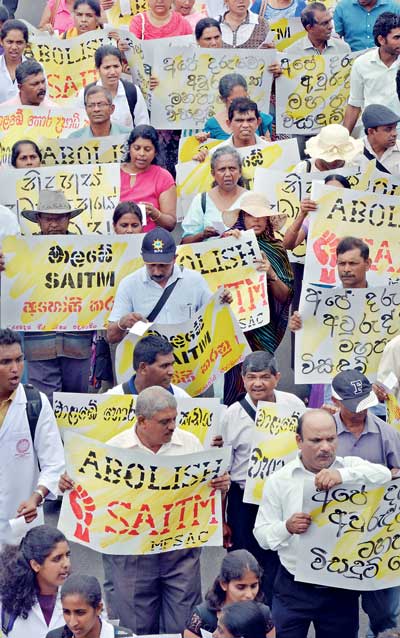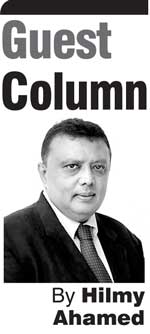Monday Mar 10, 2025
Monday Mar 10, 2025
Tuesday, 7 February 2017 00:00 - - {{hitsCtrl.values.hits}}
The Government Medical Officers Association (GMOA), the Medical Faculty Students’ Union, and Inter University Students Federation are probably in contempt of court over their continued protests and trade union action against the judgment of the Court of Appeal on the registration of students of the South Asian Institute of Technology and Medicine (SAITM) with the Sri Lanka Medical Council.
The landmark judgment delivered by the Appellate Court on Tuesday 31 January confirmed that the South Asian Institute of Technology and Medicine (SAITM) is legally eligible to grant medical degrees to its students.
The Sri Lanka Medical Council (SLMC) has been directed by the Appellate Court to grant provisional registration to medical students passing out from SAITM’s medical degree program. This verdict of the Court of Appeal was announced when the Writ Petition filed seeking an order questioning the decision of the SLMC on SAITM, was taken up for hearing before a bench headed by Justice Vijith Malalgoda. A MBBS graduate of SAITM filed the petition as the Sri Lanka Medical Council refused to register medical students who had passed out from the SAITM last year.
The University Grants Commission had granted approval and registration to SAITM on 30 August 2011 to conduct the Bachelor of Medicine and Bachelor of Surgery (MBBS) program, yet hundreds of medical students of SAITM were deprived registration by SLMC, citing inadequate clinical training.
The Neville Fernando Teaching Hospital (NFTH)was rejected by the SLMC as unsuitable for clinical training. In December 2015, at the hearing of an application filed in the Supreme Court by the SAITM students, the Health Ministry gave an undertaking to provide clinical training to the students of the South Asian Institute of Technology and Medicine (SAITM) at the Avissawella Base Hospital and the Kaduwela MOH.
Medical mafia
The medical mafia, the university students who benefit from taxpayers’ money through free education, and political opportunists have continued to protest the SAITM University’s medical degree program as a threat to free education. They ignore or fail to protest over the hundreds of other degree awarding programs undertaken by various private educational institutions. Why is it that only the private medical degree program is seen as a threat to free education?
The medical mafia of the GMOA, which holds the sick to ransom every time the Government takes any decision which benefits the majority of the citizens of the country, is spearheading a campaign against the verdict of the Appeal Court. It is time the Government addressed this menace through proper legal action against those destabilising its democratic actions.
I am reminded about the rumours floating around during the premiership and presidency of Ranasinghe Premadasa. Every time the doctors took trade union action and staged strikes, he would send his goons who would go before the protesting doctors, swing a few bicycle chains and tell them, “Dostara mahattayo, wedata giyanam hondai neda?” (‘Dear doctors, won’t it be good if you got back to work?’), and it always worked.
It is time the Government took the bull by the horns, not with the bicycle chain but through proper legal means to stop these medical professionals who have benefited from free education from holding the sick to ransom. Yes, they will resort to trade union action and cripple the health sector for a while, but for how long can they sustain it?
The Government should immediately ban private practice of medical doctors who are in Government service, if they strike or take other trade union action and deprive the poor of medical care. After all, it is mostly the poor who are forced to seek treatment at Government facilities.
In case of an emergency, there are plenty of doctors in India who could be hired to provide decent medical services if required. The Government should strip these striking doctors of their medical registration if they are not honouring their Hippocratic Oath. (The modern version of the oath is annexed at the bottom of the article for easy reference.)
Private higher education in medicine
Thousands of students who pass with above average results are denied their choice of medical education due to the dearth in State medical colleges. Some seek universities abroad at considerable cost, while others give up on their dream of treating the sick.
Private higher education in medicine was first introduced by the Government of J.R. Jayewardene as part of the open economy concept at the North Colombo Medical College (NCMC). It started with the admission of 100 local and 20 foreign students. The first batch of students was enrolled in 1990.
With similar protests as SAITM, the NCMC was nationalised in 1989 and it became the Faculty of Medicine, University of Kelaniya. The first batch of students of the Faculty of Medicine of the University of Kelaniya completed their five-year course and graduated with the MBBS degree in September 1996. They were provided registration with the Sri Lanka Medical Council.
The next attempt at a private medical university was the South Asian Institute of Technology and Medicine (SAITM), a brilliant concept and the brainchild of Dr Neville Fernando, a visionary social investor. This investment was undertaken in collaboration with the Nizhny Novgorod State Medical Academy, Russian Federation.
The final year students were offered entrance to the Nizhny Novgorod State Medical Academy in Russia, which was recognised by the Sri Lanka Medical Council, thereby allowing its graduates to practice medicine in Sri Lanka after passing the Examination for Registration to Practice Medicine (ERPM) in Sri Lanka.
SAITM also launched a local MBBS program six years ago, which was approved by the University Grants Commission. As a teaching hospital is a basic requirement for a medical degree awarding institution to provide clinical support, Dr. Neville Fernando invested heavily in setting up the Dr. Neville Fernando Teaching Hospital, a 1,002-bed facility (a bed more than the Japanese grant of the Sri Jayewardenepura hospital to J.R. Jayewardene in recognition of his support at the Treaty of San Francisco or San Francisco Peace Treaty). The NFTH claims that their hospital services are affordable to the greater majority of the local population who are average or lower middle income earners, but do not compromise on service standards or the quality of medical care.
SAITM controversy
The SAITM medical college has been one of the most controversial educational institutes since the GMOA, undergraduates from local Government medical colleges, and the SLMC banded together and made every attempt to close down this institution and deprive these undergraduates of their degrees.
The irony is that these medical students and doctors who benefit from their free education are protesting against students who are paying for their education; they are even paying for the clinical training provided by the Government.
As for the SAITM students and parents, justice has prevailed. Their heavy investment from their hard-earned savings without shipping them off to a foreign land never to return permanently to their motherland, has been rewarded.
Even today, thousands of students are studying in many overseas universities, most of which has facilities far less than SAITM. Some of these universities in China, Russia and in the former Soviet Republics, Philippines, etc. have received accreditation with the Sri Lanka Medical Council after some of SLMC inspectors have been taken on inspection tours by these universities.
How is it that the Government Medical Officers Association or any other institution did not challenge the approval of these substandard universities, but call the SAITM degree as a ‘Hora Upadi Kade’? How are these foreign universities recognised by the SLMC? Did anyone benefit personally?
During a conversation I had with the Head of the Sri Lanka Medical Council, Prof. Carlo Fonseka, I tossed the question as to why the SAITM degree has been blocked. His response sounded reasonable. He said "The SAITM students do not have exposure to forensic medicine” and hence cannot complete their clinical training. My immediate question was why the Government could not provide that training, even for a fee. His response, surprisingly, was that it was for the Government to take that decision.
It is left to be seen if the medical mafia continues to deprive the right of a private medical education in Sri Lanka for our youth, or if they will be hauled in for contempt of court.
The grouping together of the Joint Opposition, the Janatha Vimukthi Peramuna (JVP), the GMOA and the students unions does not auger well for the Government’s investment plans not just in the education sector, but will affect every other. It is important that the Government and the Judiciary takes a firm stand and deals with these saboteurs.
Discover Kapruka, the leading online shopping platform in Sri Lanka, where you can conveniently send Gifts and Flowers to your loved ones for any event including Valentine ’s Day. Explore a wide range of popular Shopping Categories on Kapruka, including Toys, Groceries, Electronics, Birthday Cakes, Fruits, Chocolates, Flower Bouquets, Clothing, Watches, Lingerie, Gift Sets and Jewellery. Also if you’re interested in selling with Kapruka, Partner Central by Kapruka is the best solution to start with. Moreover, through Kapruka Global Shop, you can also enjoy the convenience of purchasing products from renowned platforms like Amazon and eBay and have them delivered to Sri Lanka.
Discover Kapruka, the leading online shopping platform in Sri Lanka, where you can conveniently send Gifts and Flowers to your loved ones for any event including Valentine ’s Day. Explore a wide range of popular Shopping Categories on Kapruka, including Toys, Groceries, Electronics, Birthday Cakes, Fruits, Chocolates, Flower Bouquets, Clothing, Watches, Lingerie, Gift Sets and Jewellery. Also if you’re interested in selling with Kapruka, Partner Central by Kapruka is the best solution to start with. Moreover, through Kapruka Global Shop, you can also enjoy the convenience of purchasing products from renowned platforms like Amazon and eBay and have them delivered to Sri Lanka.